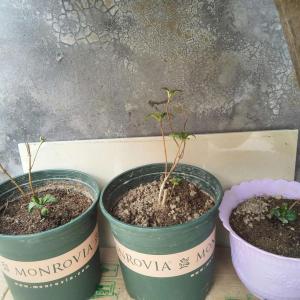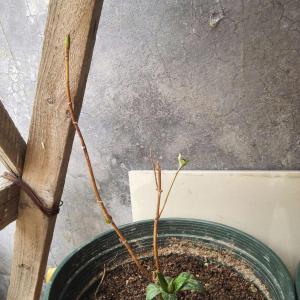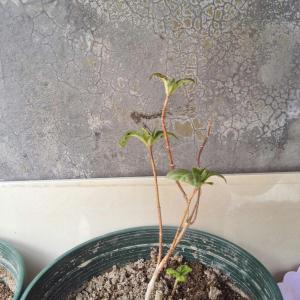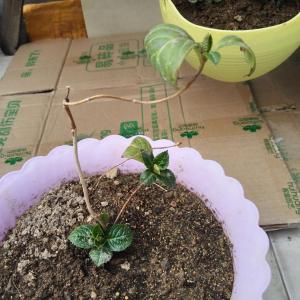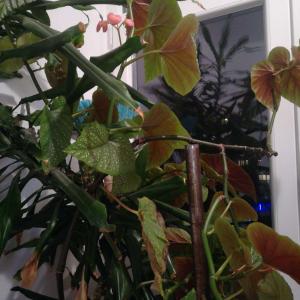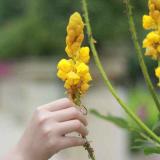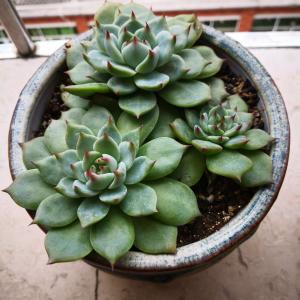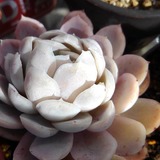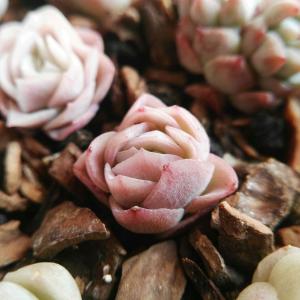Lisa Stout
2018年02月14日

Common: Blue dicks, wild hyacinth
Botanical: Dichelostemma capitatum
Native: Western North america
Size: 2 ft tall x 1 ft wide
Likes: full sun, open places, meadows, grassy, coastal, desert
Facts: bird, butterfly, and insect attractant, drought tolerant, mild fragrance, corm, deer resistant, ground cover,

Botanical: Dichelostemma capitatum
Native: Western North america
Size: 2 ft tall x 1 ft wide
Likes: full sun, open places, meadows, grassy, coastal, desert
Facts: bird, butterfly, and insect attractant, drought tolerant, mild fragrance, corm, deer resistant, ground cover,

0
0
文章
Miss Chen
2018年02月13日

Description: This herbaceous perennial plant is about ½–1' tall. It has a loose tuft of basal leaves that emerge directly from the ground. They are green in the shade and often bluish or greyish green in the sun. These basal leaves are linear with parallel venation and up to 1/6" (4 mm.) across; they resemble short narrow Iris leaves. Among the leaves, there develops occasional flowering stalks with umbels of blue-violet flowers. These flowering stalks are usually more narrow than the leaves, but they are same height or slightly taller. Each stalk terminates in a long leaf-like bract, from which a spathe with a pair of short bracts will develop. This spathe may be sessile, or it may develop from a long secondary stalk (a peduncle).

An umbel of flowers develops between the bracts of the spathe. Usually, only a few flowers in an umbel will be in bloom at the same time. Each flower is up to ½" (6 mm.) across; it consists of 3 petals and 3 sepals that appear nearly identical to each other. Each petal or sepal terminates in a tiny pointed tip that is often slightly notched on either side. There are fine lines of dark violet that lead to the center of the flower – these function as nectar guides. The base of each flower is bright yellow, from which there develops the sexual organs in the form of a bright yellow spike. At the base of each flower, there is a slender pedicel up to 1" long. There is no noticeable floral scent. The blooming period occurs during late spring or early summer, and lasts about a month. The globoid 3-celled seed capsules split into 3 sections, releasing small black seeds; these can be carried a short distance by gusts of wind. The root system is coarsely fibrous, and can form new offshoots.
Cultivation: The preference is full or partial sun and moist to average conditions. Growth is best in a rich loam that is high in organic material. Light shade is also tolerated, but flowers will be fewer in number. The plants are fairly easy to grow under these conditions, and will gradually form larger clumps. Foliar disease doesn't appear to bother this and other species of blue-eyed grass. Flower on Secondary Stalk
Range & Habitat: Stout Blue-Eyed Grass is widely distributed in Illinois, but it is less common or absent in many NW counties (see Distribution Map). This wildflower is native to Illinois. This plant can be found occasionally in moist to mesic black soil prairies, but it is more common in habitats with woody vegetation. These habitats include floodplain forests, thickets, woodland borders and openings, moist oak savannas, and the slopes of rivers. This plant usually occurs in grassy areas, as broad-leaved forbs tend to crowd it out.
Faunal Associations: Halictine bees are probably the most important visitors of the flowers, where they collect pollen or suck nectar. Bumblebees, other kinds of bees, and bee flies are less frequent visitors seeking nectar, while Syrphid flies feed on pollen or suck nectar. The seeds and other parts of this plant are eaten to a limited extent by the Greater Prairie Chicken and Wild Turkey.
Photographic Location: The photographs were taken at (or near) the webmaster's wildflower garden in Urbana, Illinois.
Comments: This is a pretty plant while in bloom, and it has neat foliage. Distinguishing different species of Blue-Eyed grass can be rather difficult. Stout Blue-Eyed Grass has leaves that are slightly broader than most species of Blue-Eyed Grass, and it occasionally produces flowers from long secondary stalks, as shown in the lower photograph. The flowers are consistently deep blue-violet, rather than pale blue or white. Only a single spathe with an umbel of flowers is produced from a flowering stalk, while Sisyrinchium albidum (White Blue-Eyed Grass) produces two spathes. If you find a Blue-Eyed Grass with blue-violet flowers in a wooded area, this is the species that you are probably looking at. Other Sisyrinchium spp. in Illinois prefer sunnier habitats in either prairies or moist sandy meadows.

An umbel of flowers develops between the bracts of the spathe. Usually, only a few flowers in an umbel will be in bloom at the same time. Each flower is up to ½" (6 mm.) across; it consists of 3 petals and 3 sepals that appear nearly identical to each other. Each petal or sepal terminates in a tiny pointed tip that is often slightly notched on either side. There are fine lines of dark violet that lead to the center of the flower – these function as nectar guides. The base of each flower is bright yellow, from which there develops the sexual organs in the form of a bright yellow spike. At the base of each flower, there is a slender pedicel up to 1" long. There is no noticeable floral scent. The blooming period occurs during late spring or early summer, and lasts about a month. The globoid 3-celled seed capsules split into 3 sections, releasing small black seeds; these can be carried a short distance by gusts of wind. The root system is coarsely fibrous, and can form new offshoots.
Cultivation: The preference is full or partial sun and moist to average conditions. Growth is best in a rich loam that is high in organic material. Light shade is also tolerated, but flowers will be fewer in number. The plants are fairly easy to grow under these conditions, and will gradually form larger clumps. Foliar disease doesn't appear to bother this and other species of blue-eyed grass. Flower on Secondary Stalk
Range & Habitat: Stout Blue-Eyed Grass is widely distributed in Illinois, but it is less common or absent in many NW counties (see Distribution Map). This wildflower is native to Illinois. This plant can be found occasionally in moist to mesic black soil prairies, but it is more common in habitats with woody vegetation. These habitats include floodplain forests, thickets, woodland borders and openings, moist oak savannas, and the slopes of rivers. This plant usually occurs in grassy areas, as broad-leaved forbs tend to crowd it out.
Faunal Associations: Halictine bees are probably the most important visitors of the flowers, where they collect pollen or suck nectar. Bumblebees, other kinds of bees, and bee flies are less frequent visitors seeking nectar, while Syrphid flies feed on pollen or suck nectar. The seeds and other parts of this plant are eaten to a limited extent by the Greater Prairie Chicken and Wild Turkey.
Photographic Location: The photographs were taken at (or near) the webmaster's wildflower garden in Urbana, Illinois.
Comments: This is a pretty plant while in bloom, and it has neat foliage. Distinguishing different species of Blue-Eyed grass can be rather difficult. Stout Blue-Eyed Grass has leaves that are slightly broader than most species of Blue-Eyed Grass, and it occasionally produces flowers from long secondary stalks, as shown in the lower photograph. The flowers are consistently deep blue-violet, rather than pale blue or white. Only a single spathe with an umbel of flowers is produced from a flowering stalk, while Sisyrinchium albidum (White Blue-Eyed Grass) produces two spathes. If you find a Blue-Eyed Grass with blue-violet flowers in a wooded area, this is the species that you are probably looking at. Other Sisyrinchium spp. in Illinois prefer sunnier habitats in either prairies or moist sandy meadows.
0
0
文章
Miss Chen
2018年02月13日

Description: This perennial plant is ½–1' tall, consisting of a tuft of basal leaves and flowering stalks that are grass-like in appearance. The basal leaves are shorter than the flowering stalks; they are both green, linear, and about 1/8" across. Each flowering stalk is narrowly winged and terminates in a pair of flower-bearing spathes and an outer leafy bract. Each spathe isClose-up of Flower sessile and consists of a pair of claw-like bracts up to 1" long; these bracts are often reddish or light brownish green. The outer leafy bract is up to 3" long. Between the bracts of each spathe, there develops a floppy umbel of flowers. Although an umbel has up to 6 flowers, only 1 or 2 flowers bloom at the same time. When it is fully open, each flower is about ½" across and consists of 6 white or pale blue tepals, a united column of yellow to orange-yellow stamens, and a green globoid ovary that is covered with fine glandular hairs. The slender pedicel of each flower is about ½" long. The blooming period occurs from late spring to early summer and lasts about 3-4 weeks; the flowers usually remain open from late morning to mid-afternoon on sunny days. There is no noticeable floral scent. Each flower is replaced by a seed capsule that is globoid and ridged; this capsule eventually turns brown and contains many small seeds. The root system consists of a tuft of coarse fibrous roots. This plant spreads by forming offsets and by reseeding itself.
Cultivation: The preference is full sun, mesic levels of moisture, and a loamy soil, although this species will adapt to other growing conditions. It often adapts well to grassy areas, but dislikes competition from taller broad-leaved forbs.
Range & Habitat: The native White Blue-Eyed Grass is occasional to locally common in most areas of Illinois; it is somewhat less common in the western half of the state (see Distribution Map). Habitats include mesic prairies, savannas, meadows in wooded areas, open woodlands, limestone glades, and grassy areas along railroads. This species can be found in degraded meadows with Kentucky Bluegrass, as well as higher quality prairies with native bunch grasses. Occasional wildfires are probably beneficial in preventing this species from becoming smothered by the decaying remains of taller vegetation.
Faunal Associations: Various kinds of bees and flower flies visit the flowers for nectar or pollen; the bees are probably more effective at cross-pollination. I have observed a small dark beetle gnawing on the flowers; it remains unidentified. Little else is known about floral-faunal relationships for this species.

Photographic Location: The webmaster's wildflower garden in Urbana, Illinois. In one photograph, a long leafy bract lies above the spathes. The bracts of the outer spathe are readily observable, while the bracts of the inner spathe are emerging from the leafy bract.
Comments: This is one of the more common Sisyrinchium sp. in Illinois. White Blue-Eyed Grass can be rather variable in appearance: one common form is short (about 6" high) with white flowers, while another form is tall (about 12" high) with pale blue flowers. White Blue-Eyed Grass is the only Sisyrinchium sp. in Illinois with 2 sessile spathes at the apex of each flowering stalk. Only one of the spathes may be evident when a flowering stalk begins to bloom; however, both spathes (each consisting of a pair of claw-like bracts) should be observable later during the blooming period or when the seed capsules develop. Other Sisyrinchium spp. produce a single sessile spathe on each flowering stalk, or they produce spathes on long secondary stalks (peduncles) at least occasionally. Sometimes Sisyrinchium albidum is called Common Blue-Eyed Grass.
Cultivation: The preference is full sun, mesic levels of moisture, and a loamy soil, although this species will adapt to other growing conditions. It often adapts well to grassy areas, but dislikes competition from taller broad-leaved forbs.
Range & Habitat: The native White Blue-Eyed Grass is occasional to locally common in most areas of Illinois; it is somewhat less common in the western half of the state (see Distribution Map). Habitats include mesic prairies, savannas, meadows in wooded areas, open woodlands, limestone glades, and grassy areas along railroads. This species can be found in degraded meadows with Kentucky Bluegrass, as well as higher quality prairies with native bunch grasses. Occasional wildfires are probably beneficial in preventing this species from becoming smothered by the decaying remains of taller vegetation.
Faunal Associations: Various kinds of bees and flower flies visit the flowers for nectar or pollen; the bees are probably more effective at cross-pollination. I have observed a small dark beetle gnawing on the flowers; it remains unidentified. Little else is known about floral-faunal relationships for this species.

Photographic Location: The webmaster's wildflower garden in Urbana, Illinois. In one photograph, a long leafy bract lies above the spathes. The bracts of the outer spathe are readily observable, while the bracts of the inner spathe are emerging from the leafy bract.
Comments: This is one of the more common Sisyrinchium sp. in Illinois. White Blue-Eyed Grass can be rather variable in appearance: one common form is short (about 6" high) with white flowers, while another form is tall (about 12" high) with pale blue flowers. White Blue-Eyed Grass is the only Sisyrinchium sp. in Illinois with 2 sessile spathes at the apex of each flowering stalk. Only one of the spathes may be evident when a flowering stalk begins to bloom; however, both spathes (each consisting of a pair of claw-like bracts) should be observable later during the blooming period or when the seed capsules develop. Other Sisyrinchium spp. produce a single sessile spathe on each flowering stalk, or they produce spathes on long secondary stalks (peduncles) at least occasionally. Sometimes Sisyrinchium albidum is called Common Blue-Eyed Grass.
0
0
文章
Miss Chen
2018年02月12日

Description: This annual plant is about ½–1½' tall. It has stems that are unbranched or sparingly branched below, becoming more branched above; they are ascending to erect. The stems are light green, terete, slender, and glabrous to minutely pubescent. In addition, there are usually sticky patches along the stems between adjacent pairs of leaves; these sticky patches are often discolored and they may have dead insects, spider webs, and other debris clinging to them. The nodes of the stems, where pairs of leaves occur, are somewhat swollen and enveloped by short sheaths with membranous upper margins. Opposite leaves are sparsely distributed along the entire length of each stem, where they are sessile. These leaves are up to 2" long and 10 mm. across, although they are usually about one-half that size. The leaves are linear-lanceolate or linear-elliptic in shape, while their margins are entire (toothless) and minutely ciliate. The upper and lower surfaces of leaves are light green or light-medium green; they are glabrous to sparsely and minutely pubescent, except at their bases, where some white hairs occur. The leaves usually have conspicuous central veins, along which they are either flat or angled slightly upward. The upper stems terminate in small clusters of flowers (one floral cluster per stem); each floral cluster has relatively few flowers (typically only 2-4). The pedicels are up to 12 mm. (½" long), light green, terete, and slender.
Flowering Plant with Dead Flying Insect
Each flower is about 4-5 mm. across, consisting of an open-ovoid calyx with 6 teeth, 5 small petals, 10 stamens, and a pistil with 3 styles. The petals are usually white, although sometimes they are pink or purple to a greater or lesser degree. Some plants produce bicolored petals that are white above and purple below, while other plants produce flowers that lack petals. These petals are obovate in shape and notched at their tips. A mature calyx is about 6-9 mm. long and about one-half as much across. Each calyx has 10 longitudinal ribs that are slightly elevated, angular-convex, and relatively thick; they are separated by narrow shallow furrows. The ribs of the calyx are often a slightly darker shade of green than the furrows; the calyx overall is light-medium green, glabrous, and sticky. The blooming period occurs from late spring to mid-summer, lasting about 1 month for a colony of plants. However, some plants may bloom later in the year in response to disturbance. The flowers are diurnal, opening up in response to bright sunlight. There is no noticeable floral scent. Mature seeds are less than 1 mm. in length, reniform (kidney-shaped), minutely bumpy across their surfaces, and black; they are distributed to some extent by the wind. The root system consists of a branching taproot. Reproduction is entirely by seeds.

Cultivation: The preference is full sun and rather dry conditions. Poor gravelly, cindery, or sandy soil is preferred, as this reduces competition from other plants. In open situations with exposed topsoil, this plant can reseed itself readily, becoming rather weedy.
Range & Habitat: Sleepy Catchfly occurs in most counties of Illinois, where it is widely distributed and native (see Distribution Map). Depending on the area, this plant is occasional to common. Habitats include gravel prairies, hill prairies, dry sand prairies, rocky glades, thinly wooded bluffs, pastures in upland areas, abandoned fields, areas along railroads, and roadsides. Sleepy Catchfly is more common in habitats that have been subjected to occasional wildfires, or that have been disturbed by human activities.

Faunal Associations: Primarily flies and small bees visit the flowers for nectar or pollen. Flies and other small insects can become stuck on the sticky surface of the calyx, while ants can become stuck on the sticky patches of stems. Sleepy Catchfly is not able to absorb nutrients from these trapped insects, however, in the manner of a carnivorous plant. An aphid, Aphis sambuci (Elder Aphid), uses Silene spp. as summer host plants, feeding on the sap of their roots. There are also two tortoise beetles, Cassida flaveola (Pale Tortoise Beetle) and Cassida azurea (Neon Tortoise Beetle), that have been introduced into North America to control such Eurasian weeds as Silene vulgaris (Bladder Campion) and Silene pratensis (White Campion). It is possible that these tortoise beetles may feed on some native Silene spp. in open weedy areas, although this has not been demonstrated for Sleepy Catchfly.
Photographic Location: The photographs were taken near an abandoned railroad in Urbana, Illinois, on black cindery ground.

Comments: Sleepy Catchfly is a highly variable plant that is easily overlooked, except where it occurs in substantial colonies and happens to be in bloom. The plant in the photographs is a form of Sleepy Catchfly with bicolored flowers, Silene antirrhina bicolor, which is supposed to be uncommon. Plants that produce flowers without petals are referred to as Silene antirrhina apetala, while plants without sticky patches on their stems are referred to as Silene antirrhina deaneana; see Mohlenbrock (2001) for a short discussion of these forms. Prior to flowering, Sleepy Catchfly resembles some species of chickweed (Stellaria spp.) with grass-like leaves. However, Sleepy Catchfly can be distinguished from these species by the sticky patches on its stems. In addition, the flowers of Sleepy Catchfly differ from those of chickweeds by having larger bladder-shaped calyces, as described above. There are also non-native Silene spp. that resemble Sleepy Catchfly to some extent (e.g., Silene conica, Silene dichotoma, and Silene gallica). These species also lack sticky patches on their stems, and their flowers can differ in such characteristics as the number of styles, the number of stamens, the number of ribs or veins along the sides of their calyces, the number of teeth along the upper rims of their calyces, and the presence of hairs or bristles along the sides of their calyces.
Flowering Plant with Dead Flying Insect
Each flower is about 4-5 mm. across, consisting of an open-ovoid calyx with 6 teeth, 5 small petals, 10 stamens, and a pistil with 3 styles. The petals are usually white, although sometimes they are pink or purple to a greater or lesser degree. Some plants produce bicolored petals that are white above and purple below, while other plants produce flowers that lack petals. These petals are obovate in shape and notched at their tips. A mature calyx is about 6-9 mm. long and about one-half as much across. Each calyx has 10 longitudinal ribs that are slightly elevated, angular-convex, and relatively thick; they are separated by narrow shallow furrows. The ribs of the calyx are often a slightly darker shade of green than the furrows; the calyx overall is light-medium green, glabrous, and sticky. The blooming period occurs from late spring to mid-summer, lasting about 1 month for a colony of plants. However, some plants may bloom later in the year in response to disturbance. The flowers are diurnal, opening up in response to bright sunlight. There is no noticeable floral scent. Mature seeds are less than 1 mm. in length, reniform (kidney-shaped), minutely bumpy across their surfaces, and black; they are distributed to some extent by the wind. The root system consists of a branching taproot. Reproduction is entirely by seeds.

Cultivation: The preference is full sun and rather dry conditions. Poor gravelly, cindery, or sandy soil is preferred, as this reduces competition from other plants. In open situations with exposed topsoil, this plant can reseed itself readily, becoming rather weedy.
Range & Habitat: Sleepy Catchfly occurs in most counties of Illinois, where it is widely distributed and native (see Distribution Map). Depending on the area, this plant is occasional to common. Habitats include gravel prairies, hill prairies, dry sand prairies, rocky glades, thinly wooded bluffs, pastures in upland areas, abandoned fields, areas along railroads, and roadsides. Sleepy Catchfly is more common in habitats that have been subjected to occasional wildfires, or that have been disturbed by human activities.

Faunal Associations: Primarily flies and small bees visit the flowers for nectar or pollen. Flies and other small insects can become stuck on the sticky surface of the calyx, while ants can become stuck on the sticky patches of stems. Sleepy Catchfly is not able to absorb nutrients from these trapped insects, however, in the manner of a carnivorous plant. An aphid, Aphis sambuci (Elder Aphid), uses Silene spp. as summer host plants, feeding on the sap of their roots. There are also two tortoise beetles, Cassida flaveola (Pale Tortoise Beetle) and Cassida azurea (Neon Tortoise Beetle), that have been introduced into North America to control such Eurasian weeds as Silene vulgaris (Bladder Campion) and Silene pratensis (White Campion). It is possible that these tortoise beetles may feed on some native Silene spp. in open weedy areas, although this has not been demonstrated for Sleepy Catchfly.
Photographic Location: The photographs were taken near an abandoned railroad in Urbana, Illinois, on black cindery ground.

Comments: Sleepy Catchfly is a highly variable plant that is easily overlooked, except where it occurs in substantial colonies and happens to be in bloom. The plant in the photographs is a form of Sleepy Catchfly with bicolored flowers, Silene antirrhina bicolor, which is supposed to be uncommon. Plants that produce flowers without petals are referred to as Silene antirrhina apetala, while plants without sticky patches on their stems are referred to as Silene antirrhina deaneana; see Mohlenbrock (2001) for a short discussion of these forms. Prior to flowering, Sleepy Catchfly resembles some species of chickweed (Stellaria spp.) with grass-like leaves. However, Sleepy Catchfly can be distinguished from these species by the sticky patches on its stems. In addition, the flowers of Sleepy Catchfly differ from those of chickweeds by having larger bladder-shaped calyces, as described above. There are also non-native Silene spp. that resemble Sleepy Catchfly to some extent (e.g., Silene conica, Silene dichotoma, and Silene gallica). These species also lack sticky patches on their stems, and their flowers can differ in such characteristics as the number of styles, the number of stamens, the number of ribs or veins along the sides of their calyces, the number of teeth along the upper rims of their calyces, and the presence of hairs or bristles along the sides of their calyces.
0
0
文章
Miss Chen
2018年02月12日

Description: This annual plant is 1-2½' tall, branching occasionally. The stems are light green and somewhat ridged. The lower stems often sprawl along the ground in open areas, otherwise this plant is erect. The compound leaves alternate along the stems. They are evenly pinnate, usually with 3 pairs of leaflets, and have long leaf stems (primary petioles). The obovate leaflets are individually 1½" long and 1" across. They are devoid of hairs and pale green on their undersides. There is an extra-floral nectary close to the lowest pair of leaflets on the upper side of each compound leaf. This nectary resembles a small brown spike. The foliage has a slightly rank odor.
One or two flowers develop from the upper axils of the compound leaves. These flowers have pedicels about 1" long and tend to nod slightly downward. They are about 1" across, and consist of 5 rounded yellow petals and 10 stamens; the petals are often slightly unequal in size. The flowers are subtended by a light green calyx that is divided into 5 folded sepals; these sepals are shorter than the petals and hairless. In Illinois, the blooming period occurs from late summer through the fall, and lasts about 1-2 months. There is no floral scent. A long seedpod develops from each flower that is 4-6" long, but only 1/3" across. This seedpod curves downward and resembles a sickle in its overall shape. The root system consists of taproot. This plant spreads by reseeding itself.
Cultivation: The preference is full sun and moist to slightly dry conditions. This plant tolerates different kinds of soil, from fertile loam to gravelly soil; in fact, it often thrives in railroad ballast. Drought tolerance is good, and the foliage is rarely bothered by foliar disease. It is somewhat slow to develop for an annual plant, and tends to bloom late in the year in Illinois.

Range & Habitat: Sicklepod has been reported from only a few counties in southern Illinois and in the Chicago area; it has been observed recently along a railroad track in Champaign County, where it is probably adventive from the south (see Distribution Map). This is a rare plant in Illinois, although it is more common in many south-central and southeastern states of the US; it also occurs in the American tropics. In southern Illinois, Sicklepod may be native, while elsewhere in the state it is definitely adventive from the south. Habitat information is scanty, but it has been observed in moist meadows along rivers, open areas along railroads, and in waste areas. Areas with a history of disturbance are preferred.
Faunal Associations: The extra-floral nectaries attract ants primarily; they may also attract some wasps, flies, or small bees. The pollen of the flowers attract long-tongued bees, such as bumblebees, Miner bees, and large Leaf-Cutting bees. The caterpillars of several species of Sulfur butterflies are known to feed on the foliage of Cassia spp., including Eurema lisa (Little Sulfur), Eurema nicippe (Sleepy Orange), and Phoebis sennae cubule (Cloudless Sulfur). Some upland gamebirds occasionally eat the seeds of Senna spp., especially the Bobwhite and Greater Prairie Chicken. Mammalian herbivores are unlikely to utilize this plant as a food source to any significant extent because of the unpleasant taste and toxic nature of the foliage, which has been found capable of poisoning livestock.

Photographic Location: Photographs were taken along a railroad in Savoy, Illinois.
Comments: This rare plant has attractive foliage, but blooms sparingly. Sicklepod resembles Senna marilandica (Maryland Senna) and Senna hebecarpa (Wild Senna) somewhat in appearance, but it is a shorter annual plant that has 1) fewer leaflets per compound leaf, 2) leaflets with a more obovate shape, and 3) seedpods that are more curved and slender. In the past, Sicklepod was assigned to the Bean family (Fabaceae), rather than the Caesalpinia family.
One or two flowers develop from the upper axils of the compound leaves. These flowers have pedicels about 1" long and tend to nod slightly downward. They are about 1" across, and consist of 5 rounded yellow petals and 10 stamens; the petals are often slightly unequal in size. The flowers are subtended by a light green calyx that is divided into 5 folded sepals; these sepals are shorter than the petals and hairless. In Illinois, the blooming period occurs from late summer through the fall, and lasts about 1-2 months. There is no floral scent. A long seedpod develops from each flower that is 4-6" long, but only 1/3" across. This seedpod curves downward and resembles a sickle in its overall shape. The root system consists of taproot. This plant spreads by reseeding itself.
Cultivation: The preference is full sun and moist to slightly dry conditions. This plant tolerates different kinds of soil, from fertile loam to gravelly soil; in fact, it often thrives in railroad ballast. Drought tolerance is good, and the foliage is rarely bothered by foliar disease. It is somewhat slow to develop for an annual plant, and tends to bloom late in the year in Illinois.

Range & Habitat: Sicklepod has been reported from only a few counties in southern Illinois and in the Chicago area; it has been observed recently along a railroad track in Champaign County, where it is probably adventive from the south (see Distribution Map). This is a rare plant in Illinois, although it is more common in many south-central and southeastern states of the US; it also occurs in the American tropics. In southern Illinois, Sicklepod may be native, while elsewhere in the state it is definitely adventive from the south. Habitat information is scanty, but it has been observed in moist meadows along rivers, open areas along railroads, and in waste areas. Areas with a history of disturbance are preferred.
Faunal Associations: The extra-floral nectaries attract ants primarily; they may also attract some wasps, flies, or small bees. The pollen of the flowers attract long-tongued bees, such as bumblebees, Miner bees, and large Leaf-Cutting bees. The caterpillars of several species of Sulfur butterflies are known to feed on the foliage of Cassia spp., including Eurema lisa (Little Sulfur), Eurema nicippe (Sleepy Orange), and Phoebis sennae cubule (Cloudless Sulfur). Some upland gamebirds occasionally eat the seeds of Senna spp., especially the Bobwhite and Greater Prairie Chicken. Mammalian herbivores are unlikely to utilize this plant as a food source to any significant extent because of the unpleasant taste and toxic nature of the foliage, which has been found capable of poisoning livestock.

Photographic Location: Photographs were taken along a railroad in Savoy, Illinois.
Comments: This rare plant has attractive foliage, but blooms sparingly. Sicklepod resembles Senna marilandica (Maryland Senna) and Senna hebecarpa (Wild Senna) somewhat in appearance, but it is a shorter annual plant that has 1) fewer leaflets per compound leaf, 2) leaflets with a more obovate shape, and 3) seedpods that are more curved and slender. In the past, Sicklepod was assigned to the Bean family (Fabaceae), rather than the Caesalpinia family.
0
0
文章
Miss Chen
2018年02月10日

Description: This biennial wildflower forms a low rosette of leaves during the 1st year, bolting into an erect plant about 1-2½' tall during the 2nd year. The central stem is 4-angled, winged, and glabrous; it is unbranched below and oppositely branched above. Opposite leaves (up to 1½" long and 1" across) occur along the stems; they are medium green, glabrous, smooth along their margins, and lanceolate to oval-cordate in shape. The leaves are sessile or slightly clasp the stems. The upper stems terminate in small cymes of flowers. The pedicels of these flowers are ½–1¼" long and glabrous. When they are fully open, individual flowers are 1-1½" across. Each flower has a corolla with 5 petals, 5 stamens with yellow anthers, a superior ovary with a divided style, and a green calyx with 5 sepals that are linear-lanceolate. The petals are obovate in shape and vary in color from rose-pink to white; they are about twice the length of the sepals. At the center of the flower, the petal bases are yellow to greenish yellow, presenting a small 5-sided star. The margins of this star are outlined in dark rose-pink. When they are receptive to pollen, the 2 linear stigmata of the style become bright yellow. The blooming period occurs from mid- to late summer. The flowers open up during the day and close at night; they are fragrant. During the fall, the flowers are replaced by single-celled seed capsules about 1/3" (8 mm.) long; each capsule contains a multitude of tiny seeds that can be blown about by the wind or float on water. The root system is shallow and fibrous.

Cultivation: The preference is full or partial sun and moist conditions. The soil can contain loam, sand, silt, or some rocky/gravelly material.
Range & Habitat: Common Rose Pink is occasional in the southern half of Illinois, while in the northern half of the state it is rare or absent (see Distribution Map). This plant is native to the state. Habitats include moist prairies and sand prairies, moist sandy thickets, marshes and sandy marshes, interdunal swales, rocky glades, openings in rocky woodlands, sandy pits on mined land, poorly drained fields, and roadsides. This wildflower can be found in both degraded and higher quality habitats.
Faunal Associations: The flowers are cross-pollinated by long-tongued bees and possibly other diurnal insects with long mouthparts (e.g., butterflies and skippers). Charles Robertson (1929) observed a little carpenter bee, Ceratina dupla, and a large leaf-cutting bee, Megachile brevis, visiting the flowers for nectar or pollen. The caterpillars of the moth, Agyrostrotis anilis (Short-Lined Chocolate), feed on Sabatia spp. (Rose Pinks). Common Rose Pink is a bitter-tasting plant, but it is unclear to what extent this may deter its consumption by mammalian herbivores.
Photographic Location: A prairie in Fayette County, Illinois. The photographs of the flowering plants were taken by Keith & Patty Horn (Copyright © 2009).
Comments: Like other species in this genus, Common Rose Pink is a showy and attractive plant. It resembles an oversized version of Centaurium pulchellum (Branching Centaury) from Europe, which is also in the Gentian family. Another species, Sabatia campestris (Prairie Rose Pink), also occurs in Illinois; it is usually found in drier habitats. Prairie Rose Pink differs from Common Rose Pink by its tendency to branch alternately, rather than oppositely. It also has 5 vertical ribs along the tubular portion of its calyx, while the calyx of Common Rose Pink lacks such ribs. Other common names that have been applied to Sabatia angularis include Rose Gentian, Marsh Pink, and Bitterbloom.

Cultivation: The preference is full or partial sun and moist conditions. The soil can contain loam, sand, silt, or some rocky/gravelly material.
Range & Habitat: Common Rose Pink is occasional in the southern half of Illinois, while in the northern half of the state it is rare or absent (see Distribution Map). This plant is native to the state. Habitats include moist prairies and sand prairies, moist sandy thickets, marshes and sandy marshes, interdunal swales, rocky glades, openings in rocky woodlands, sandy pits on mined land, poorly drained fields, and roadsides. This wildflower can be found in both degraded and higher quality habitats.
Faunal Associations: The flowers are cross-pollinated by long-tongued bees and possibly other diurnal insects with long mouthparts (e.g., butterflies and skippers). Charles Robertson (1929) observed a little carpenter bee, Ceratina dupla, and a large leaf-cutting bee, Megachile brevis, visiting the flowers for nectar or pollen. The caterpillars of the moth, Agyrostrotis anilis (Short-Lined Chocolate), feed on Sabatia spp. (Rose Pinks). Common Rose Pink is a bitter-tasting plant, but it is unclear to what extent this may deter its consumption by mammalian herbivores.
Photographic Location: A prairie in Fayette County, Illinois. The photographs of the flowering plants were taken by Keith & Patty Horn (Copyright © 2009).
Comments: Like other species in this genus, Common Rose Pink is a showy and attractive plant. It resembles an oversized version of Centaurium pulchellum (Branching Centaury) from Europe, which is also in the Gentian family. Another species, Sabatia campestris (Prairie Rose Pink), also occurs in Illinois; it is usually found in drier habitats. Prairie Rose Pink differs from Common Rose Pink by its tendency to branch alternately, rather than oppositely. It also has 5 vertical ribs along the tubular portion of its calyx, while the calyx of Common Rose Pink lacks such ribs. Other common names that have been applied to Sabatia angularis include Rose Gentian, Marsh Pink, and Bitterbloom.
0
0
文章
Miss Chen
2018年02月10日

Description: This herbaceous perennial plant is about 1' tall, branching occasionally. The stems are light green and covered with white hairs. The opposite leaves are up to 2½" long and 1" wide, and broadly lanceolate, deltoid, or ovate in form. They are light green to green, with smooth margins, and are covered with white hairs on both the upper and lower sides. The leaves also have hairy petioles. The light lavender or light purple flowers are funnel-shaped, with 5 flared lobes, and range in length from 1½-2½". There are usually fine purple lines towards the center of the corolla that function as nectar guides to visiting insects. There is no noticeable floral scent. A flower typically opens during the morning and falls off the plant by evening. The overall appearance of Hairy Wild Petunia resembles cultivated petunias, but they are members of different plant families. The blooming period occurs from early summer to late summer, and lasts about 2 months. The root system is fibrous. The dark seeds are fairly large and fall to the ground not far from the mother plant.

Cultivation: It's quite adaptable, tolerating full or partial sun, moist to dry conditions, and practically any kind of soil. Under moist conditions with rich soil, however, this plant is unable to compete with taller, more aggressive plants. Disease doesn't seem to bother it.
Range & Habitat: This native plant occurs occasionally throughout Illinois, but it is most likely to be absent in the NW counties (see Distribution Map). Hairy Wild Petunia occurs in mesic to dry black soil prairies, gravelly hill prairies, dry open woodlands, limestone glades, bluffs, sandy cemeteries, sand flats, and areas along roadsides and railroads. This plant is typically found in areas with poor soil and sparse vegetative cover, where it occurs sporadically in short grass, rather than forming dense colonies.
Faunal Associations: Long-tongued bees are the most important pollinators of the flowers, including Anthophorid bees and Leaf-Cutting bees. The latter sometimes cut the petals, which are used in the construction of brood nests. Short-tongued bees and Syrphid flies also visit the flowers, but they collect stray pollen and are not effective pollinators. The light color and funnel-like shape of the diurnal flowers suggest that they may be visited by day-flying Sphinx moths and Hummingbird moths, but apparently this has not been observed. It has been reported that the caterpillars of the butterfly Junonia coenia (Buckeye) may feed on the foliage of Ruellia spp. occasionally.
Photographic Location: Photographs were taken at the Red Bison Railroad Prairie in Savoy, Illinois.
Comments: Because of its large and abundant flowers, the Hairy Wild Petunia is grown occasionally in flower gardens, particularly along borders, or in rock gardens. It's an attractive little plant. There is some variation in the shape and hairiness of the leaves, depending on the local ecotype. There are other Ruellia spp. with similar flowers that occur in woodland areas – they tend to be taller plants with less hairy leaves.

Cultivation: It's quite adaptable, tolerating full or partial sun, moist to dry conditions, and practically any kind of soil. Under moist conditions with rich soil, however, this plant is unable to compete with taller, more aggressive plants. Disease doesn't seem to bother it.
Range & Habitat: This native plant occurs occasionally throughout Illinois, but it is most likely to be absent in the NW counties (see Distribution Map). Hairy Wild Petunia occurs in mesic to dry black soil prairies, gravelly hill prairies, dry open woodlands, limestone glades, bluffs, sandy cemeteries, sand flats, and areas along roadsides and railroads. This plant is typically found in areas with poor soil and sparse vegetative cover, where it occurs sporadically in short grass, rather than forming dense colonies.
Faunal Associations: Long-tongued bees are the most important pollinators of the flowers, including Anthophorid bees and Leaf-Cutting bees. The latter sometimes cut the petals, which are used in the construction of brood nests. Short-tongued bees and Syrphid flies also visit the flowers, but they collect stray pollen and are not effective pollinators. The light color and funnel-like shape of the diurnal flowers suggest that they may be visited by day-flying Sphinx moths and Hummingbird moths, but apparently this has not been observed. It has been reported that the caterpillars of the butterfly Junonia coenia (Buckeye) may feed on the foliage of Ruellia spp. occasionally.
Photographic Location: Photographs were taken at the Red Bison Railroad Prairie in Savoy, Illinois.
Comments: Because of its large and abundant flowers, the Hairy Wild Petunia is grown occasionally in flower gardens, particularly along borders, or in rock gardens. It's an attractive little plant. There is some variation in the shape and hairiness of the leaves, depending on the local ecotype. There are other Ruellia spp. with similar flowers that occur in woodland areas – they tend to be taller plants with less hairy leaves.
0
0
文章
Miss Chen
2018年02月09日

Description: This perennial wildflower is 1-3' tall, branching occasionally. The stems are medium green and minutely rough-pubescent to glabrous. The spreading alternate leaves are up to 6" long and 2" across; they are pinnatifid or double-pinnatifid with 5-11 lobes, medium green, and minutely rough-pubescent to glabrous. The slender lobes are linear-oblong and sometimes have 1-2 dentate teeth or smaller cleft lobes; they are 1/3" (8 mm.) across or less. Irregularities in the structure of the leaves are rather common. The petioles are up to 2" long.
Occasionally, the upper stems terminate in individual flowerheads on long naked stalks (peduncles). These stalks are 2-12" long and finely grooved. The flowerheads are about 1½–3" long and a little less across. Each flowerhead consists of a cylindrical head of numerous disk florets, which is surrounded by 4-11 drooping rays (ray florets). A mature head of disk florets is ¾–1¾" long; it is initially gray or greenish gray, later becoming dark brown. The rays are about ½–1¼" long, oblong in shape, and slightly notched at their tips; they are either yellow, maroon (reddish brown), or yellow with basal patches of maroon. The typical form of Mexican Hat has yellow rays, while plants with maroon rays are referred to as f.Distribution Map pulcherrima. The bottom of each flowerhead is defined by 2 series of small narrow bracts; these are largely hidden by the drooping rays. The blooming period occurs during the summer and lasts about 1-2 months. Fertile disk florets are replaced by small oblongoid achenes; each achene usually has one or more tiny scales at its apex. This plant spreads to new areas by reseeding itself.
Cultivation: The preference is full sun, dry conditions, and a relatively barren soil containing clay, gravel, or sand. On moist fertile ground, this wildflower has trouble competing with taller and more aggressive plants.
Range & Habitat: Mexican Hat is adventive from the the Great Plains and western states; the eastern boundary of its range extends into western Iowa and Missouri. In Illinois, naturalized populations of Mexican Hat are uncommon; they are found primarily in the northern and western sections of the state. Habitats include upland prairies, roadsides, areas along railroads, and barren waste areas. This wildflower is often cultivated in gardens, from which it sometimes escapes. In Illinois, Mexican Hat is found primarily in disturbed areas, where it may or may not persist.
Faunal Associations: Various insects are attracted to the nectar and pollen of the flowerheads. Floral visitors of Mexican Hat are probably similar to those insects that are known to visit the flowerheads of Ratibida pinnata (Yellow Coneflower). Likely visitors include various short-tongued bees, wasps, flies, beetles, and the occasional butterfly or skipper. The caterpillars of some moths are known to feed on Ratibida spp. (primarily the rays and florets). These species include Homoeosoma electellum (Sunflower Moth), Chlorochlamys chloroleuca (Blackberry Looper Moth), Eupithecia miserulata (Common Pug), Synchlora aerata (Wavy-Lined Emerald), and Epiblema iowana (Tortricid Moth sp.). The caterpillars of the latter moth feed on the roots.
Photographic Location: A flower garden in downtown Champaign, Illinois. The photographed plant is Ratibida columnifera pulcherrima.

Comments: This is a colorful prairie wildflower. Mexican Hat can be distinguished from Ratibida pinnata (Yellow Coneflower) by its long cylindrical heads, which usually exceed the length of the rays at maturity. The ovoid-globoid heads of Yellow Coneflower, in contrast, are much shorter than the length of their rays. Other common names of Ratibida columnifera are Long-Headed Coneflower and Prairie Coneflower. The common name that is used here, 'Mexican Hat,' refers to the fancied resemblance of the flowerhead to a sombrero.
Occasionally, the upper stems terminate in individual flowerheads on long naked stalks (peduncles). These stalks are 2-12" long and finely grooved. The flowerheads are about 1½–3" long and a little less across. Each flowerhead consists of a cylindrical head of numerous disk florets, which is surrounded by 4-11 drooping rays (ray florets). A mature head of disk florets is ¾–1¾" long; it is initially gray or greenish gray, later becoming dark brown. The rays are about ½–1¼" long, oblong in shape, and slightly notched at their tips; they are either yellow, maroon (reddish brown), or yellow with basal patches of maroon. The typical form of Mexican Hat has yellow rays, while plants with maroon rays are referred to as f.Distribution Map pulcherrima. The bottom of each flowerhead is defined by 2 series of small narrow bracts; these are largely hidden by the drooping rays. The blooming period occurs during the summer and lasts about 1-2 months. Fertile disk florets are replaced by small oblongoid achenes; each achene usually has one or more tiny scales at its apex. This plant spreads to new areas by reseeding itself.
Cultivation: The preference is full sun, dry conditions, and a relatively barren soil containing clay, gravel, or sand. On moist fertile ground, this wildflower has trouble competing with taller and more aggressive plants.
Range & Habitat: Mexican Hat is adventive from the the Great Plains and western states; the eastern boundary of its range extends into western Iowa and Missouri. In Illinois, naturalized populations of Mexican Hat are uncommon; they are found primarily in the northern and western sections of the state. Habitats include upland prairies, roadsides, areas along railroads, and barren waste areas. This wildflower is often cultivated in gardens, from which it sometimes escapes. In Illinois, Mexican Hat is found primarily in disturbed areas, where it may or may not persist.
Faunal Associations: Various insects are attracted to the nectar and pollen of the flowerheads. Floral visitors of Mexican Hat are probably similar to those insects that are known to visit the flowerheads of Ratibida pinnata (Yellow Coneflower). Likely visitors include various short-tongued bees, wasps, flies, beetles, and the occasional butterfly or skipper. The caterpillars of some moths are known to feed on Ratibida spp. (primarily the rays and florets). These species include Homoeosoma electellum (Sunflower Moth), Chlorochlamys chloroleuca (Blackberry Looper Moth), Eupithecia miserulata (Common Pug), Synchlora aerata (Wavy-Lined Emerald), and Epiblema iowana (Tortricid Moth sp.). The caterpillars of the latter moth feed on the roots.
Photographic Location: A flower garden in downtown Champaign, Illinois. The photographed plant is Ratibida columnifera pulcherrima.

Comments: This is a colorful prairie wildflower. Mexican Hat can be distinguished from Ratibida pinnata (Yellow Coneflower) by its long cylindrical heads, which usually exceed the length of the rays at maturity. The ovoid-globoid heads of Yellow Coneflower, in contrast, are much shorter than the length of their rays. Other common names of Ratibida columnifera are Long-Headed Coneflower and Prairie Coneflower. The common name that is used here, 'Mexican Hat,' refers to the fancied resemblance of the flowerhead to a sombrero.
0
0





